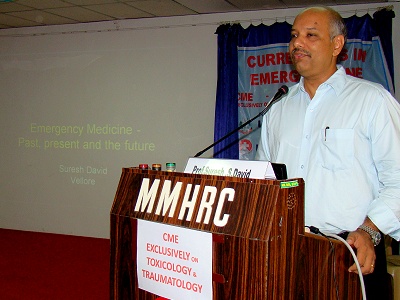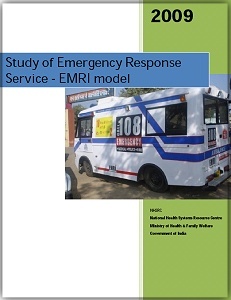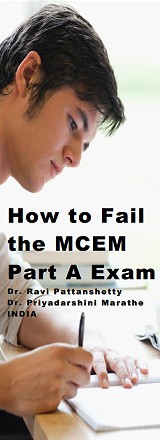EmergencyMedicine.in
EMinside
Favorites
Recommended
ATLS India - Advanced Trauma Life Support
 atls.in
atls.in 
American College of Emergency Physicians
 acep.org
acep.org
College of Emergency Medicine, United Kingdom
 rcem.ac.uk
rcem.ac.uk
Australasian College of Emergency Emergency Medicine
 acem.org.au
acem.org.au
 atls.in
atls.in 
American College of Emergency Physicians
 acep.org
acep.orgCollege of Emergency Medicine, United Kingdom
 rcem.ac.uk
rcem.ac.ukAustralasian College of Emergency Emergency Medicine
 acem.org.au
acem.org.auLet Others Know
Verified Site
Visitor Stats
Dr. Suresh David speaks on Past , Present & Future of EM in India
 Dr. Suresh David, Professor & Head of Dept of Accident & Emergency Medicine, Christian Medical College (CMC), Vellore, India, is the senior most emergency physician in India with more than 18 years of EM experience and one of the pioneers for the development of emergency medicine in India. He is a honorary recipient of the Fellowship of Australian College of Emergency Medicine (FACEM) in 2006.
Dr. Suresh David, Professor & Head of Dept of Accident & Emergency Medicine, Christian Medical College (CMC), Vellore, India, is the senior most emergency physician in India with more than 18 years of EM experience and one of the pioneers for the development of emergency medicine in India. He is a honorary recipient of the Fellowship of Australian College of Emergency Medicine (FACEM) in 2006. CMC Vellore has the distinction of having developed the first independent emergency medicine department in the country, in 1994. The 44 bed ED, with an annual flow of more than 45000 patients, has been conducting structured training in emergency medicine & emergency nursing since 1997.
The department faculty team presented various CME lectures in toxicology at Meenakshi Mission Hospital & Research Centre, Madurai, Tamil Nadu, India on 7th June 2009. Dr. David presented a talk on Emergency Medicine in India - Past, Present & the Future
He said that EM is not yet officially recognized as a specialty in India and the main reason was due to the non-existence of EM postgraduate training by the Medical Council of India (MCI). The obstacles for EMs genesis in India included the inertia of policy makers i.e. MCI, who were unfamiliar to the concept of EM, unconvinced of its relevance in the practice of medicine and they believe that EM is still taught by respective specialties.
The pitfalls in the existing system were ineffective emergency departments or casualties, incompetent staffing and poor networking. He also said that EM training opportunities were only available at a small number of private institutes which included CMC, Vellore.
Dr. David also pointed out that the National Board of Examinations (which is another independent body responsible for postgradute education in India) was ready to recognize EM postgraduate specialty training but was hesitant to do it without MCI recognition. The previously available post MS fellowship was a poor substitute for basic specialty training and had a low uptake among specialists due to poor job opportunities.
He said that the main steps which would be needed are recognition of EM as a specialty by the MCI, implementation of PG training program and inclusion of EM training into the undergraduate curriculum. He also said that emergency physicians in India were a loose collection of clinicians with a common interest, most of them were half cooked and working in ineffective EDs.
The future cannot be predicted but EM popularity will rise when the PG program is on the horizon
- Suresh S David, 2009
Dr. Suresh David also informed that work was underway for a comprehensive textbook in emergency medicine which will focus on EM from the Indian perspective.
.
Journal of Emergency Medicine in India (JEMI)
The increased awareness of internet and online media has brought in another new entry into Indian emergency medicine. The first online Journal of Emergency Medicine in India (JEMI) is now accessible at www.jemi.in
With an editorial board consisting of EM physicians both from India & abroad, JEMI aims to publish articles, reviews, case reports & series, clinical trials & investigations, etc. The journal will have bimonthly issues as per the website.
Although most of the site pages are still under construction, we believe that the team is working quickly towards completion of the website.
Incidentally, another online journal Journal for Emergencies, Trauma & Shock (JETS) published by the INDO-US Emergency & Trauma Collaborative has also been online for Indian viewers since 2008. Indo-US Trauma Collaborative(www.indusem.com) is joint academic effort between the University of South Florida, USA and All India Institute of Medical Sciences (AIIMS). JETS is focused on emergency medicine, traumatology & shock resuscitation.
The Journal for Emergencies, Trauma & Shock can be reached at www.onlinejets.org
Both JETS & JEMI are open access, which is a very good thing.
.
With an editorial board consisting of EM physicians both from India & abroad, JEMI aims to publish articles, reviews, case reports & series, clinical trials & investigations, etc. The journal will have bimonthly issues as per the website.
Although most of the site pages are still under construction, we believe that the team is working quickly towards completion of the website.
Incidentally, another online journal Journal for Emergencies, Trauma & Shock (JETS) published by the INDO-US Emergency & Trauma Collaborative has also been online for Indian viewers since 2008. Indo-US Trauma Collaborative(www.indusem.com) is joint academic effort between the University of South Florida, USA and All India Institute of Medical Sciences (AIIMS). JETS is focused on emergency medicine, traumatology & shock resuscitation.
The Journal for Emergencies, Trauma & Shock can be reached at www.onlinejets.org
Both JETS & JEMI are open access, which is a very good thing.
.
GVK faces uphill task in resuscitating EMRI
GVK faces uphill task in resuscitating EMRI
Even as GVK takes over the beleaguered Emergency Management and Research Institute (EMRI), analysts observe that the EMRI model has several operational loopholes that need to be looked into immediately in order to sustain the service in the country.
Read the full article in TIMES OF INDIA - 29 May 2009
.
Even as GVK takes over the beleaguered Emergency Management and Research Institute (EMRI), analysts observe that the EMRI model has several operational loopholes that need to be looked into immediately in order to sustain the service in the country.
Read the full article in TIMES OF INDIA - 29 May 2009
.
Study of Emergency Response Service in India - EMRI Model
Study of Emergency Response Service in India - EMRI Model
 A much discussed and successful public private partnership model for ERS (Emergency Response Service) is the 108 Emergency Service being managed and operationalised by EMRI (Emergency Management and Research Institute) in many states in India like Andhra Pradesh, Gujarat, Uttarakhand, and Rajasthan with around 1500 ambulances running. The 108 number in India aims to be equivalent to 911 of the United States. EMRI has been operational since August 2005.
A much discussed and successful public private partnership model for ERS (Emergency Response Service) is the 108 Emergency Service being managed and operationalised by EMRI (Emergency Management and Research Institute) in many states in India like Andhra Pradesh, Gujarat, Uttarakhand, and Rajasthan with around 1500 ambulances running. The 108 number in India aims to be equivalent to 911 of the United States. EMRI has been operational since August 2005.
The EMRI managed ERS in Andhra Pradesh has become a bench-mark for ERS in India and various other states are in the process of adopting the EMRI model. This had called for a review of the original EMRI model of Andhra Pradesh to draw lessons for designing ERS in other states in India.
The study on Emergency Response Services, with specific reference to the EMRI (Emergency Management & Research Institute) model in states like Andhra Pradesh and Gujarat, had been commissioned under the National Rural Health Mission (NRHM), Ministry of Health & Family Welfare, Government of India, in November 2008, at the request of Shri G.C. Chaturvedi (Additional Secretary and Mission Director). A team from the National Health Systems Resource Centre (NHSRC) is conducting this landmark analysis.
The aims of this study are divided in two parts
First Part (Overview Appraisal)
Interviews with EMRI, collection of key documents and analysis of data presented by EMRI to understand and recommend on utilisation, requirements, effectiveness and efficiency of operations, financing arrangements and governance mechanisms and institutional frameworks.
Second part
To undertake a sample study, using a small number of research teams, across three states with the purpose of
a. Validating data presented by EMRI.
b. Understand further on patterns of use, and equity issues.
c. Examine HR issues related to service delivery.
d. Look at quality of service delivery
The widely awaited findings of the first part have been made available by the Ministry of Health & Family Welfare.(mohfw.nic.in)
The full document can be viewed at
Study of Emergency Response Service (in India) - EMRI Model
.
 A much discussed and successful public private partnership model for ERS (Emergency Response Service) is the 108 Emergency Service being managed and operationalised by EMRI (Emergency Management and Research Institute) in many states in India like Andhra Pradesh, Gujarat, Uttarakhand, and Rajasthan with around 1500 ambulances running. The 108 number in India aims to be equivalent to 911 of the United States. EMRI has been operational since August 2005.
A much discussed and successful public private partnership model for ERS (Emergency Response Service) is the 108 Emergency Service being managed and operationalised by EMRI (Emergency Management and Research Institute) in many states in India like Andhra Pradesh, Gujarat, Uttarakhand, and Rajasthan with around 1500 ambulances running. The 108 number in India aims to be equivalent to 911 of the United States. EMRI has been operational since August 2005.The EMRI managed ERS in Andhra Pradesh has become a bench-mark for ERS in India and various other states are in the process of adopting the EMRI model. This had called for a review of the original EMRI model of Andhra Pradesh to draw lessons for designing ERS in other states in India.
The study on Emergency Response Services, with specific reference to the EMRI (Emergency Management & Research Institute) model in states like Andhra Pradesh and Gujarat, had been commissioned under the National Rural Health Mission (NRHM), Ministry of Health & Family Welfare, Government of India, in November 2008, at the request of Shri G.C. Chaturvedi (Additional Secretary and Mission Director). A team from the National Health Systems Resource Centre (NHSRC) is conducting this landmark analysis.
The aims of this study are divided in two parts
First Part (Overview Appraisal)
Interviews with EMRI, collection of key documents and analysis of data presented by EMRI to understand and recommend on utilisation, requirements, effectiveness and efficiency of operations, financing arrangements and governance mechanisms and institutional frameworks.
Second part
To undertake a sample study, using a small number of research teams, across three states with the purpose of
a. Validating data presented by EMRI.
b. Understand further on patterns of use, and equity issues.
c. Examine HR issues related to service delivery.
d. Look at quality of service delivery
The widely awaited findings of the first part have been made available by the Ministry of Health & Family Welfare.(mohfw.nic.in)
The full document can be viewed at
Study of Emergency Response Service (in India) - EMRI Model
.
EMcounter
Project EMcounter, an initiative of Dr. Satchit Balsari from Newyork-Presbyterian Hospital, aims to document the distribution and characteristics of medical emergencies in the developing world via a web-based data collection tool.
The first results of this project have been published in the International Journal of Emergency Medicine (April 2008).
Click here to read the full article EMcounter-charting the epidemiology of medical emergencies in India: A status report at IJEM
The YouTube video shown here was created by EMcounter.
The first results of this project have been published in the International Journal of Emergency Medicine (April 2008).
Click here to read the full article EMcounter-charting the epidemiology of medical emergencies in India: A status report at IJEM
The YouTube video shown here was created by EMcounter.







